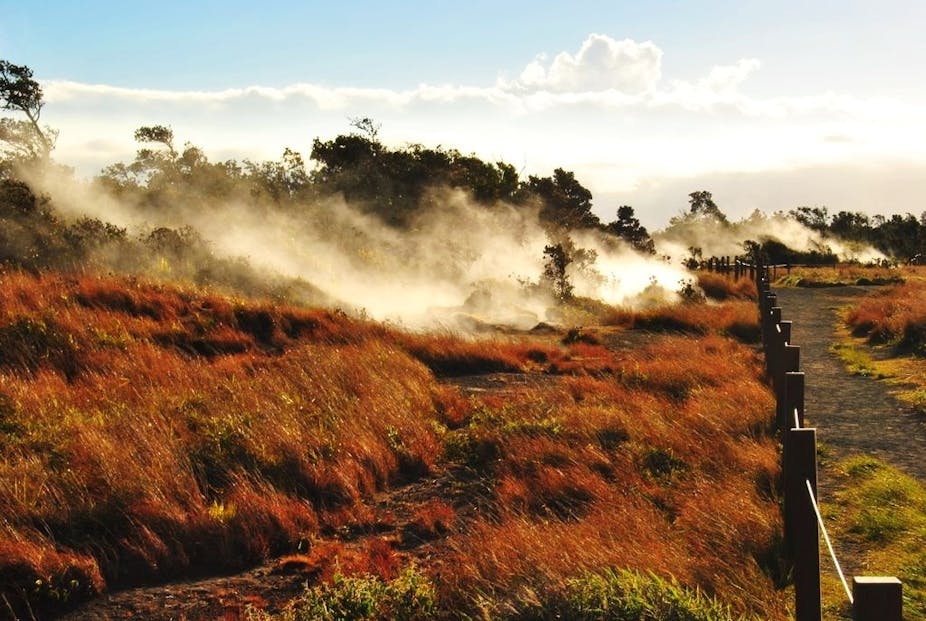Geothermal means, literally, “earth heat”. The temperature of the earth increases as we drill deeper towards its core. We can use that heat for energy by circulating water through hot subterranean reservoirs, bringing the hot water or steam to the surface. We can then convert the energy in the hot fluid to mechanical and electrical power at the surface using a heat engine.
The private investment in Australian geothermal power development slowed down after a very fast start ten years ago. This should pick up again as new developments bring commercial viability to enhanced geothermal systems. These have the potential to grow exponentially, promising abundant power for the world.
Conventional geothermal systems
In 2010, the world generated 20 terawatt hours (TWh) of geothermal electricity. All of this came from conventional resources. These are naturally occurring hot water or steam flows heated by magma and circulating through permeable rock. They are associated with volcanic systems and limited to regions with active or young volcanoes.
The use of conventional resources is not new. In 1904, a plant was built in Larderello, Italy, to generate electricity from geothermal steam. Since then, geothermal power installations have spread at a steady rate but have been limited to resources that are relatively easy to access.
Enhanced geothermal systems
There is another form of geothermal heat that is abundant and generally available around the globe. It is produced by the radioactive decay of potassium, uranium, and thorium isotopes found in some granite types.
In granites in the Cooper Basin, in South Australia, there are isotope concentrations at trace level. Heat is generated at a very low rate. At such a low rate, it would take almost one million years for a mass of granite to increase its temperature by 100°C. Through that time the rock has to remain well-insulated at great depth.
To access this deep heat, at least two wells must be drilled. Cold water is injected from one well, it is heated by the rock and is extracted from the other well. The two wells are typically 800 to 1000m apart. In such a system, the water will travel from one well to the other only if the rock between the wells is sufficiently permeable.
Natural rock permeability is not high enough but can be enhanced by well-established oil and gas engineering techniques. These systems are called Enhanced Geothermal Systems (EGS).
Commercial EGS development
Electricity from enhanced geothermal systems is not cost-competitive now because deep wells are expensive. To generate enough electricity to pay for the wells and for the surface equipment, the hot water has to be brought to the surface at rates close to 100kg/s. One of the best EGS flow rates in the world was achieved by the Australian company Geodynamics, and it was only a third of this target. Although this is a significant achievement, it is not enough to make EGS electricity commercially competitive.
It’s possible to compensate for these low flow rates if you can improve the efficiency of converting the energy into power. But improvements in this area have yet to see electricity production become cost-competitive.
EGS flow rates must be tripled before EGS electricity is commercially feasible. It was reported last December that a promising technique for geothermal wells might have been developed by the US company AltaRock. If the reported results are substantiated by further testing, it will provide new breath for the EGS geothermal development around the world and in Australia.
Other Australian geothermal resources
The division between conventional and enhanced geothermal systems is artificial and the actual global geothermal resource covers a continuous spectrum extending from naturally occurring hot springs to enhanced geothermal systems.
Recent results show that although Australia is not a volcanic country, it has areas where magma gets close to the surface to produce hot water in sedimentary rock. The Australian geothermal industry calls these hot sedimentary aquifers. They are expected to have natural permeabilities higher than EGS but maybe not as high as conventional geothermal systems.
Around the world, there has not been much work in this type of resource but there are new developments in Australia as well as other places like Turkey and South America directed at such resources.
Environmental impacts
In accessing geothermal energy, the technologies involved can have slight effects on the immediate environment. As seen by the Paralana experience, slight tremors may be felt on the surface but these do not constitute a significant risk. Geothermal energy does not use any more water than other renewable thermal power energy applications. Also the fracture stimulation used in the EGS projects does not pose a risk for surface aquifers because EGS reservoirs are very deep and the wells are sealed in steel casings.
In some volcanically-sourced conventional geothermal resources, the dissolved gases released to the atmosphere may affect the immediate environment. This is probably the most serious hazard associated with geothermal energy but it is limited only to some conventional resources (not relevant to Australia) and is easy to control.
The future for geothermal
The fundamentals for geothermal energy are strong. It is abundant – the resource underneath the Great Artesian basin is estimated to be large enough to deliver the current Australian annual energy consumption for 6000 years. It is one of the few renewable power sources that can completely replace coal as a baseload electricity generator. It also has a very low environmental impact.
The failure to achieve sufficient flow was hindering its commercial development but this problem may be solved in the near future. If that happens, geothermal power could become one of the leading renewable power technologies for the 2020s.

